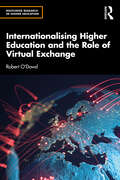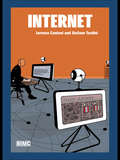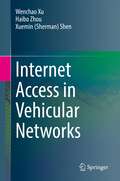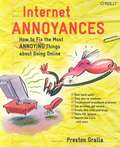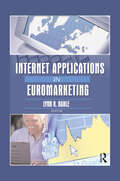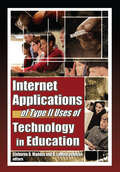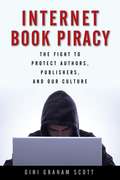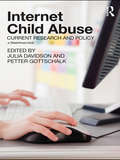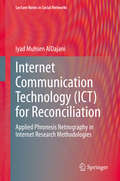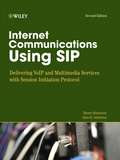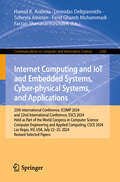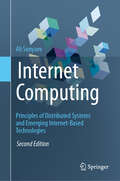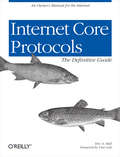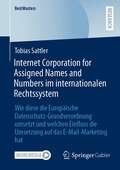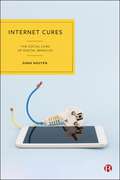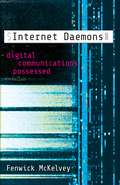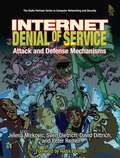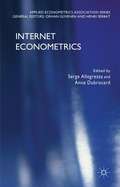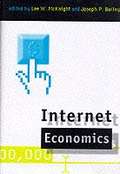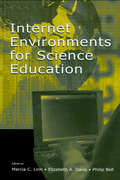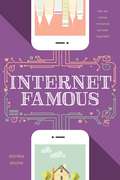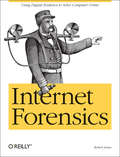- Table View
- List View
Internationalising Higher Education and the Role of Virtual Exchange (Routledge Research in Higher Education)
by Robert O'DowdThis volume introduces Virtual Exchange (VE) as an innovative form of online intercultural learning and investigates the myriad of ways VE is being carried out across universities, ultimately arguing for its integration into university internationalisation policies and course curricula. Against the backdrop of increased digitalisation initiatives throughout universities given the effects of the pandemic, chapters focus not only on providing new research findings, but also on providing a comprehensive introduction and argumentation for the use of VE in university education and also in demonstrating how it can be put into use by both university decision-makers and educators. Reviewing the limitations of the activity, this timely work also fundamentally posits how VE and blended mobility more broadly could be developed in future higher education initiatives. This book will be of interest to researchers, academics, scholars, and students involved with Open & Distance Education and eLearning, approaches to internationalisation in education, and the study of higher education more broadly. Those interested in innovative methods for teaching and learning, as well as educational research, will also benefit from this volume.
Internet
by Lorenzo Cantoni Stefano TardiniFrom music to gaming, information gathering to eLearning; eCommerce to eGovernment, Lorenzo Cantoni and Stefano Tardini's absorbing introduction considers the internet as a communication technology; the opportunities it affords us, the limitations it imposes and the functions it allows. Internet explores: the political economy of the internet hypertext computer mediated communication websites as communication conceptualizing users of the internet internet communities and practices. Perfect for students studying this modern phenomenon, and a veritable e-feast for all cyber junkies.
Internet Access in Vehicular Networks
by Haibo Zhou Xuemin (Sherman) Shen Wenchao XuThis book introduces the Internet access for vehicles as well as novel communication and computing paradigms based on the Internet of vehicles. To enable efficient and reliable Internet connection for mobile vehicle users, this book first introduces analytical modelling methods for the practical vehicle-to-roadside (V2R) Internet access procedure, and employ the interworking of V2R and vehicle-to-vehicle (V2V) to improve the network performance for a variety of automotive applications. In addition, the wireless link performance between a vehicle and an Internet access station is investigated, and a machine learning based algorithm is proposed to improve the link throughout by selecting an efficient modulation and coding scheme.This book also investigates the distributed machine learning algorithms over the Internet access of vehicles. A novel broadcasting scheme is designed to intelligently adjust the training users that are involved in the iteration rounds for an asynchronous federated learning scheme, which is shown to greatly improve the training efficiency. This book conducts the fully asynchronous machine learning evaluations among vehicle users that can utilize the opportunistic V2R communication to train machine learning models. Researchers and advanced-level students who focus on vehicular networks, industrial entities for internet of vehicles providers, government agencies target on transportation system and road management will find this book useful as reference. Network device manufacturers and network operators will also want to purchase this book.
Internet Annoyances
by Preston GrallaWhat began as an intrepid U.S. Government initiative in the early 1970's has turned into a global way of life. Indeed, with more than 500 million current users (and counting), the Internet has revolutionized the way societies function the world over. From dating and shopping online, to conducting informational research, to communicating via email, today seemingly everyone uses the Internet for one purpose or another. How, then, can something so vast and powerful be defiled by something as trivial as spam? It's true. The fact remains that despite the leading-edge technological sophistication fueling the Net, there are still many related annoyances that complicate and tarnish the Internet experience. And it doesn't matter if you're a homemaker in search of a fresh chicken recipe, or a civil engineer researching plans for a new skyscraper, the problems are the same. Internet Annoyances understands the universal nature of the Internet and strives to make its use as stress-free as possible. This insightful guide shows you how to overcome the most annoying Internet-related quirks, bugs, and hassles. You'll learn how to make a seamless connection, thwart would-be hackers, ensure greater security while surfing, eliminate pop-up ads, maximize online services, conduct more effective Google searches, better utilize digital media (music and video), and much more. In addition, Internet Annoyances discusses how to design and host a personal web site something once thought of as only possible for the technically gifted. Topics like blogs, domain names, setup, HTML, fonts, and graphics and are all dissected and analyzed for easy consumption. Unlike other books on the subject, Internet Annoyances assumes readers already possess a working knowledge of the Internet. By fully recognizing the experience level of today's Internet culture, author Preston Galla is able to cut immediately to the chase and not waste time on the more obvious points. Internet Annoyances , therefore, is a quick read that presents succinct solutions for the many glitches that still populate the Internet experience.
Internet Applications in Euromarketing
by Lynn R. Kahle Erdener KaynakExplore Internet marketing from cross-cultural and cross-national perspectives! This book examines cutting-edge theory and practice on Internet marketing, putting the latest research on the best ways to exploit this interactive advertising medium in your hands. In Internet Applications in Euromarketing, scholars from Europe and the United States examine essential facets of Internet use, both as a means of product promotion and as a facilitator of consumers? purchasing decisions. Internet Applications in Euromarketing considers the effectiveness of combining Web advertising with traditional media, looks at ways to make banner ads pay off, highlights techniques for reaching older consumers via the Internet, shows how to take advantage of online word-of-mouth advertising, and more! The handy charts and tables in this well-referenced book make important points of information easy to access and understand. Internet Applications in Euromarketing looks in-depth at what works and what doesn?t, addressing the questions on marketers? minds (and some that many haven?t thought of yet), including: Where is a company?s marketing money best spent?what are the media effects for Internet exposure vs. television and print? Is it useful to mention a price, a rebate, or a gift to encourage the Internet user to move from the banner?s host site to the brand?s site? What are the Internet habits and preferences of seniors, and what are the best ways to reach them? Are banner ads that are disguised as messages from the user?s operating system more effective than those that simply appear as advertising? How can we generate word-of-mouth Internet communication?via e-mail, newsgroups, bulletin boards, chat rooms, etc.?and establish credibility? What are the advantages of online discussions over traditional focus groups?
Internet Applications of Type II Uses of Technology in Education
by Cleborne D. Maddux D. LaMont JohnsonGive your students a powerful learning resource-the Internet!The Internet, though brimming with potential, is still vastly underused as a teaching resource. Internet Applications of Type II Uses of Technology in Education gives teachers new strategies for the Internet&’s use as a dynamic educational resource. Where Type I teaching applications technologically mimic the procedures previously used by teachers, Type II teaching applications involve innovative thinking in the use of technology in learning. Using Type II applications with the Internet, students are actively empowered to look to its use as an effective partner in their learning process. This book clearly reviews several Type II teaching applications and integrative software for use in all educational levels, including Internet videoconferencing, instant messages, WebQuests, and WebCT.Though now readily available, even those schools with the capability fail to effectively integrate computer and Internet technology into meaningful classroom activities. Using the Internet as a teaching and learning tool offers a flexibility that can be extremely effective. Internet Applications of Type II Uses of Technology in Education clearly shows how some creative educators have implemented inventive Type II applications in their teaching plans to give their students a more enriching learning experience.Internet Applications of Type II Uses of Technology in Education explores: critically evaluating Web site information how perceptions and behaviors change when Internet access becomes universally available Internet2 Videoconferencing integrating online communication into courses utilizing computer-mediated communication (CMC) tools structured online class discussions using Instant Messenger (IM) increasing vocabulary through software and online texts online learning in second-language acquisition (SLA) a project in New Zealand in which teachers and students learn Web design with the help of an external expert WebQuests as a Type II application WebCT as a Type II application achievement testing through the computer the Global Forum on School Leadership (GFSL) as a Type II applicationInternet Applications of Type II Uses of Technology in Education is a valuable, idea-generating resource for all academics working in information technology and education, and for K-12 teachers and administrators at all levels.
Internet Book Piracy: The Fight to Protect Authors, Publishers, and Our Culture
by Gini Graham ScottThe international battle against Internet pirates has been heating up. Increasingly law enforcement is paying attention to book piracy as ebook publishing gains an ever-larger market share. With this threat to their health and even survival, publishers and authors must act much like the music, film, and software giants that have waged war against pirates for the past two decades. Now, The Battle against Internet Piracy opens a discussion on what happens to the victims of piracy. Drawing from a large number of interviews-from writers, self-publishers, mainstream publishers, researchers, students, admitted pirates, free speech advocates, attorneys, and local and international law enforcement officials-the text speaks to such issues as: Why pirates have acted and how they feel about it The conflict over constitutional rights and piracy The current laws surrounding Internet piracy Examples of cases taken against some pirates Alternatives to piracy Personal experiences of being ripped off The ways piracy affects different industries and how they’ve respondedAuthor Gini Graham Scott prepares readers to arm themselves against these modern perils by learning about copyright, infringement, and how to prevent, combat, and end book piracy.Allworth Press, an imprint of Skyhorse Publishing, publishes a broad range of books on the visual and performing arts, with emphasis on the business of art. Our titles cover subjects such as graphic design, theater, branding, fine art, photography, interior design, writing, acting, film, how to start careers, business and legal forms, business practices, and more. While we don't aspire to publish a New York Times bestseller or a national bestseller, we are deeply committed to quality books that help creative professionals succeed and thrive. We often publish in areas overlooked by other publishers and welcome the author whose expertise can help our audience of readers.
Internet Branding For Lawyers: Building The Client-centered Website
by Jeff LantzCovering methods applicable to firms serving individuals as well as firms serving businesses, this reader-friendly guide shows how to create a brand and a website for a law firm. Lantz, a consultant in brand creation and website development who holds an MBA in finance, advises readers to focus on the customer perspective: how will you help me and how much will it cost. The book begins by explaining the increased importance of branding in today's information age, then explains how to build a brand around the law firm's practices and how to communicate the brand through website content and design. The final section of the book is given over to technical details and decisions related to areas such as content management systems, choosing a website developer, search optimization, domain names, and servers and website hosting. The book includes many bullets and checklists, along with b&w photos, screenshots, and examples of logos. Annotation ©2012 Book News, Inc. , Portland, OR (booknews. com)
Internet Child Abuse: Current Research and Policy
by Julia DavidsonInternet Child Abuse: Current Research and Policy provides a timely overview of international policy, legislation and offender management and treatment practice in the area of Internet child abuse. Internet use has grown considerably over the last five years, and information technology now forms a core part of the formal education system in many countries. There is however, increasing evidence that the Internet is used by some adults to access children and young people in order to ‘groom’ them for the purposes of sexual abuse; as well as to produce and distribute indecent illegal images of children. This book presents and assesses the most recent and current research on internet child abuse, addressing: its nature, the behaviour and treatment of its perpetrators, international policy, legislation and protection, and policing. It will be required reading for an international audience of academics, researchers, policy-makers and criminal justice practitioners with interests in this area.
Internet Communication Technology: Applied Phronesis Netnography in Internet Research Methodologies (Lecture Notes in Social Networks)
by Iyad Muhsen AlDajaniThe book explores Applied Phronesis in internet communication technology and Netnography application, introducing it on Facebook and YouTube usages. It defines two pillars for the research dynamics, “Episteme” and “Techne.” – the know-how, how-to, and the power dynamics. The “Episteme” explores the dynamics of reconciliation in the middle of conflict, Internet communication technologies for transformation, Moderation in Islam, online Deliberative Democracy.The second pillar, “Techne,” is explored through Internet communication technology for the advancement of reconciliation in the middle of a conflict.The book describes the Phronetic Approach in internet research in academic discourse adopting Phronesis “an Aristotelian concept and method defined by Bent Flyvbjerg,” and exploring Netnography for Kozinets, in Mixed-Method research design and applying methodological triangulation in research and testing the hypothesis using qualitative content analysis for Krippendorff, developing a methodological discourse for interdisciplinary research using internet communication technologies as part of understanding big-date, introducing Applied Digital Humanities.
Internet Communications Using SIP
by Henry Sinnreich Alan B. Johnston"This book is like a good tour guide.It doesn't just describe the major attractions; you share in the history, spirit, language, and culture of the place."--Henning Schulzrinne, Professor, Columbia UniversitySince its birth in 1996, Session Initiation Protocol (SIP) has grown up. As a richer, much more robust technology, SIP today is fully capable of supporting the communication systems that power our twenty-first century work and life.This second edition handbook has been revamped to cover the newest standards, services, and products. You'll find the latest on SIP usage beyond VoIP, including Presence, instant messaging (IM), mobility, and emergency services, as well as peer-to-peer SIP applications, quality-of-service, and security issues--everything you need to build and deploy today's SIP services.This book will help you* Work with SIP in Presence and event-based communications* Handle SIP-based application-level mobility issues* Develop applications to facilitate communications access for users with disabilities* Set up Internet-based emergency services* Explore how peer-to-peer SIP systems may change VoIP* Understand the critical importance of Internet transparency* Identify relevant standards and specifications* Handle potential quality-of-service and security problems
Internet Computing and IoT and Embedded Systems, Cyber-physical Systems, and Applications: 25th International Conference, ICOMP 2024, and 22nd International Conference, ESCS 2024, Held as Part of the World Congress in Computer Science, Computer Engineering and Applied Computing, CSCE 2024, Las Vegas, NV, USA, July 22–25, 2024, Revised Selected Papers (Communications in Computer and Information Science #2260)
by Hamid R. Arabnia Leonidas Deligiannidis Soheyla Amirian Farzan Shenavarmasouleh Farid Ghareh MohammadiThis book constitutes the proceedings of the 25th International Conference on Internet Computing and IoT, ICOMP 2024, and the 22nd International Conference on Embedded Systems, Cyber-physical Systems, and Applications, ESCS 2024, held as part of the 2024 World Congress in Computer Science, Computer Engineering and Applied Computing, in Las Vegas, USA, during July 22 to July 25, 2024. The 23 papers from IVOMP 2024 have been carefully reviewed and selected from 122 submissions. ESCS 2024 received 49 submissions and accepted 11 papers for inclusion in the proceedings. The papers have been organized in topical sections as follows: Internet computing and IoT - Cloud and Internet of Things; Internet computing and IoT - algorithms and applications; and embedded systems, cyber-physical systems and applications.
Internet Computing: Principles of Distributed Systems and Emerging Internet-Based Technologies
by Ali SunyaevThe 2nd edition of this well-established textbook introduces the reader to the fundamentals of contemporary and emerging technologies and services in Internet computing. It covers essential concepts such as distributed systems architecture and web technologies, contemporary paradigms such as cloud, fog, and edge computing, the Internet of things, and emerging technologies like distributed ledger technologies and the InterPlanetary File System. The book also highlights the interconnection and recombination of these Internet-based technologies, which together form a critical information infrastructure with major impacts on individuals, organizations, governments, economies, and society as a whole. Intended as a textbook for upper undergraduate and graduate classes, it features a wealth of examples, learning goals and summaries for every chapter, numerous recommendations for further reading, and questions for checking students’ comprehension. A dedicated author website offers additional teaching material and more elaborate examples. Accordingly, the book enables students and young professionals in IT-related fields to familiarize themselves with the Internet’s basic mechanisms, and with the most promising Internet-based technologies of our time.
Internet Core Protocols: Help for Network Administrators
by Eric HallIf you've ever been responsible for a network, you know that sinking feeling: your pager has gone off at 2 a.m., the network is broken, and you can't figure out why by using a dial-in connection from home. You drive into the office, dig out your protocol analyzer, and spend the next fourhours trying to put things back together before the staff shows up for work.When this happens, you often find yourself looking at the low-level guts of the Internet protocols: you're deciphering individual packets, trying to figure out what is (or isn't) happening. Until now, the only real guide to the protocols has been the Internet RFCs--and they're hardlywhat you want to be reading late at night when your network is down. There hasn't been a good book on the fundamentals of IP networking aimed at network administrators--until now.Internet Core Protocols: The Definitive Guide contains all the information you need for low-level network debugging. It provides thorough coverage of the fundamental protocols in the TCP/IP suite: IP, TCP, UDP, ICMP, ARP (in its many variations), and IGMP. (The companion volume, Internet Application Protocols: The Definitive Guide,provides detailed information about the commonly used application protocols, including HTTP, FTP, DNS, POP3, and many others). It includes many packet captures, showing you what to look for and how to interpret all the fields. It has been brought up to date with the latest developments in real-world IP networking. The CD-ROM included with the book contains Shomiti's "Surveyor Lite," a packet analyzer that runs on Win32 systems, plus the original RFCs, should you need them for reference. Together, this package includes everything you need to troubleshoot your network--except coffee.
Internet Corporation for Assigned Names and Numbers im internationalen Rechtssystem: Wie diese die Europäische Datenschutz-Grundverordnung umsetzt und welchen Einfluss die Umsetzung auf das E-Mail-Marketing hat (BestMasters)
by Tobias SattlerFür den stabilen und sicheren Betrieb des Internets ist die US-amerikanische gemeinnützige Organisation Internet Corporation for Assigned Names and Numbers (ICANN) verantwortlich, wozu die Koordination der Vergabe von Domain-Namen gehört. Die Europäische Datenschutz-Grundverordnung (EU-DSGVO) dient der Vereinheitlichung des Datenschutzrechts und schützt die Verarbeitung von personenbezogenen Daten. Dies hat einen Einfluss auf die öffentlich zugänglichen Informationen von registrierten Domain-Namen, deren Veröffentlichung die ICANN in ihren Richtlinien vorschreibt. Diese Informationen umfassen personenbezogene Daten wie den Namen, die Postanschrift und die E-Mail-Adresse der Domain-innehabenden Person. Die ICANN änderte ihre Richtlinien, jedoch ist weiterhin die Veröffentlichung dieser Angaben möglich. In dem vorliegenden Buch werden die Auswirkungen der EU-DSGVO auf das E-Mail-Marketing und die Verwendung von E-Mail-Adressen für E-Mail-Kampagnen untersucht, insbesondere in Bezug auf unerwünschte E-Mail-Werbung. Dazu wird die folgende Forschungsfrage gestellt: Welchen Effekt hat die Veröffentlichung der E-Mail-Adresse der Domain-innehabenden Person in den WHOIS-Datenbanken auf die Anzahl eingehender unerwünschter Marketing-E-Mails?
Internet Cures: The Social Lives of Digital Miracles
by Dang NguyenIn health care, we come across daily promises of miraculous cures for various ailments. However, in the digital era, the dynamics of experiencing and practicing these remedies have changed. This book explores the intersection of miracle cures and technology, showcasing their transformation into hybrid forms, such as handwritten recipes captured in photos or tutorials streamed through videos. Combining computational social media data with ethnographic insights from Vietnam and the US, the book captures the interconnected lives of these cures in the digital realm with a unique methodology. Unravelling the intricate connections between social, technological, biomedical and non-biomedical spheres, this is a significant contribution to how social scientists study online media.
Internet Daemons: Digital Communications Possessed (Electronic Mediations)
by Fenwick McKelveyA complete history and theory of internet daemons brings these little-known—but very consequential—programs into the spotlight We&’re used to talking about how tech giants like Google, Facebook, and Amazon rule the internet, but what about daemons? Ubiquitous programs that have colonized the Net&’s infrastructure—as well as the devices we use to access it—daemons are little known. Fenwick McKelvey weaves together history, theory, and policy to give a full account of where daemons come from and how they influence our lives—including their role in hot-button issues like network neutrality.Going back to Victorian times and the popular thought experiment Maxwell&’s Demon, McKelvey charts how daemons evolved from concept to reality, eventually blossoming into the pandaemonium of code-based creatures that today orchestrates our internet. Digging into real-life examples like sluggish connection speeds, Comcast&’s efforts to control peer-to-peer networking, and Pirate Bay&’s attempts to elude daemonic control (and skirt copyright), McKelvey shows how daemons have been central to the internet, greatly influencing everyday users.Internet Daemons asks important questions about how much control is being handed over to these automated, autonomous programs, and the consequences for transparency and oversight.
Internet Denial of Service: Attack and Defense Mechanisms
by Jelena Mirkovic Sven Dietrich David Dittrich Peter ReiherSuddenly your Web server becomes unavailable. When you investigate, you realize that a flood of packets is surging into your network. You have just become one of the hundreds of thousands of victims of a denial-of-service attack, a pervasive and growing threat to the Internet. What do you do? <p><p> Internet Denial of Service sheds light on a complex and fascinating form of computer attack that impacts the confidentiality, integrity, and availability of millions of computers worldwide. It tells the network administrator, corporate CTO, incident responder, and student how DDoS attacks are prepared and executed, how to think about DDoS, and how to arrange computer and network defenses. It also provides a suite of actions that can be taken before, during, and after an attack.
Internet Dos and Don'ts: Keep Your Passwords Secret
by Shannon MillerPasswords are important personal information that should not be shared--not even with a best friend. Readers will learn why password privacy is key to their safety and the potential consequences of telling others confidential information.
Internet Econometrics
by Serge Allegrezza Anne DubrocardThe proliferation of the internet has often been referred to as the fourth technological revolution. This book explores the diffusion of radical new communication technologies, and the subsequent transformation not only of products, but also of the organisation of production and business methods.
Internet Economics
by Lee W. Mcknight Joseph P. BaileyThe Internet has rapidly become an important element of the economic system. The lack of accepted metrics for economic analysis of Internet transactions is therefore increasingly problematic. This book, one of the first to bring together research on Internet engineering and economics, attempts to establish such metrics. The chapters, which developed out of a 1995 workshop held at MIT, include architectural models and analyses of Internet usage, as well as alternative pricing policies. The book is organized into six sections: 1) Introduction to Internet Economics, 2) The Economics of the Internet, 3) Interconnection and Multicast Economics, 4) Usage Sensitive Pricing, 5) Internet Commerce, and 6) Internet Economics and Policy. Contributors: Loretta Anania, Joseph P. Bailey, Nevil Brownlee, David Carver, David Clark, David W. Crawford, Ketil Danielsen, Deborah Estrin, Branko Gerovac, David Gingold, Jiong Gong, Alok Gupta, Shai Herzog, Clark Johnson, Martyne M. Hallgren, Frank P. Kelly, Charlie Lai, Alan K. McAdams, Jeffrey K. MacKie-Mason, Lee W. McKnight, Gennady Medvinsky, Liam Murphy, John Murphy, B. Clifford Neuman, Jon M. Peha, Joseph Reagle, Mitrabarun Sarkar, Scott Shenker, Marvin A. Sirbu, Richard Jay Solomon, Padmanabhan Srinagesh, Dale O. Stahl, Hal R. Varian, Qiong Wang, Martin Weiss, Andrew B. Whinston.
Internet Election Campaigns in the United States, Japan, South Korea, and Taiwan
by Diana Owen Shoko Kiyohara Kazuhiro MaeshimaThis book investigates how institutional differences, such as the roles of political parties and the regulation of electoral systems, affect the development of Internet election campaigns in the U. S. , Japan, Korea, and Taiwan. It examines whether or not the "Americanization of elections" is evident in East Asian democracies. While Japan is a parliamentary system, the U. S. and Korea are presidential systems and Taiwan is a semi-presidential system that has a president along with a parliamentary system. Furthermore, the role of the presidency in the U. S. , Korea, and Taiwan is quite different. Taking these variations in political systems into consideration, the authors discuss how the electoral systems are regulated in relation to issues such as paid advertisements and campaign periods. They argue that stronger regulation of election systems and shorter election periods in Japan characterize Japanese uniqueness compared with the U. S. , Korea, and Taiwan in terms of Internet election campaigns.
Internet Environments for Science Education
by Marcia C. LinnInternet Environments for Science Education synthesizes 25 years of research to identify effective, technology-enhanced ways to convert students into lifelong science learners--one inquiry project at a time. It offers design principles for development of innovations; features tested, customizable inquiry projects that students, teachers, and professional developers can enact and refine; and introduces new methods and assessments to investigate the impact of technology on inquiry learning. The methodology--design-based research studies--enables investigators to capture the impact of innovations in the complex, inertia-laden educational enterprise and to use these findings to improve the innovation. The approach--technology-enhanced inquiry--takes advantage of global, networked information resources, sociocognitive research, and advances in technology combined in responsive learning environments. Internet Environments for Science Education advocates leveraging inquiry and technology to reform the full spectrum of science education activities--including instruction, curriculum, policy, professional development, and assessment. The book offers: *the knowledge integration perspective on learning, featuring the interpretive, cultural, and deliberate natures of the learner; *the scaffolded knowledge integration framework on instruction summarized in meta-principles and pragmatic principles for design of inquiry instruction; *a series of learning environments, including the Computer as Learning Partner (CLP), the Knowledge Integration Environment (KIE), and the Web-based Inquiry Science Environment (WISE) that designers can use to create new inquiry projects, customize existing projects, or inspire thinking about other learning environments; *curriculum design patterns for inquiry projects describing activity sequences to promote critique, debate, design, and investigation in science; *a partnership model establishing activity structures for teachers, pedagogical researchers, discipline experts, and technologists to jointly design and refine inquiry instruction; *a professional development model involving mentoring by an expert teacher; *projects about contemporary controversy enabling students to explore the nature of science; *a customization process guiding teachers to adapt inquiry projects to their own students, geographical characteristics, curriculum framework, and personal goals; and *a Web site providing additional links, resources, and community tools at www.InternetScienceEducation.org
Internet Famous
by Danika Stone<P>An engaging and relatable novel for the digital age that perfectly captures the complicated interaction between what goes on in our real lives and what we say online. <P>Internet sensation Madison Nakama has it all! Her pop-culture rewatch site has a massive following, and fans across the world wait on her every post and tweet. And now Laurent, a fellow geek (and unfairly HOT French exchange student!), has started flirting with her in the comments section of her blog. But Laurent’s not the only one watching for Madi’s replies… Internet fame has a price, and their online romance sparks the unwanted attention of a troll. <P>When Madi’s “real life” hits a rough patch, she feels her whole world crumbling. With Laurent’s support, can Madi rally her friends across the globe to beat the troll, or will he succeed in driving her away from everything—and everyone—she loves? <P>Internet Famous is a fresh, contemporary young adult romance for the iGeneration from Danika Stone, author of All the Feels.
Internet Forensics: Using Digital Evidence to Solve Computer Crime
by Robert JonesBecause it's so large and unregulated, the Internet is a fertile breeding ground for all kinds of scams and schemes. Usually it's your credit card number they're after, and they won't stop there. Not just mere annoyances, these scams are real crimes, with real victims. Now, thanks to Internet Forensics from O'Reilly, there's something you can do about it.This practical guide to defending against Internet fraud gives you the skills you need to uncover the origins of the spammers, con artists, and identity thieves that plague the Internet. Targeted primarily at the developer community, Internet Forensics shows you how to extract the information that lies hidden in every email message, web page, and web server on the Internet. It describes the lengths the bad guys will go to cover their tracks, and offers tricks that you can use to see through their disguises. You'll also gain an understanding for how the Internet functions, and how spammers use these protocols to their devious advantage.The book is organized around the core technologies of the Internet-email, web sites, servers, and browsers. Chapters describe how these are used and abused and show you how information hidden in each of them can be revealed. Short examples illustrate all the major techniques that are discussed. The ethical and legal issues that arise in the uncovering of Internet abuse are also addressed.Not surprisingly, the audience for Internet Forensics is boundless. For developers, it's a serious foray into the world of Internet security; for weekend surfers fed up with spam, it's an entertaining and fun guide that lets them play amateur detective from the safe confines of their home or office.
